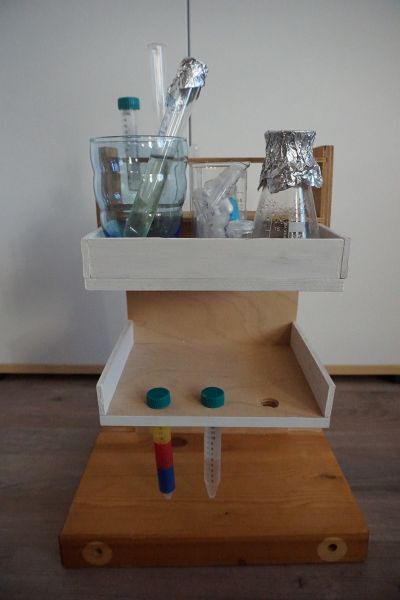No edit summary |
|||
| Line 21: | Line 21: | ||
Interesting projects which mix art and microbiology by Mellissa Fisher: | Interesting projects which mix art and microbiology by Mellissa Fisher: | ||
[https://www.mellissafisher.com/microbial-me Microbial Me] | [https://www.mellissafisher.com/microbial-me Microbial Me] | ||
[https://www.mellissafisher.com/are-we-disconnected Are we disconnected?] | [https://www.mellissafisher.com/are-we-disconnected Are we disconnected?] | ||
| Line 49: | Line 51: | ||
---- | ---- | ||
== Preparation == | == Preparation == | ||
Revision as of 14:46, 22 December 2020
Project
My project which I try to implement will be a picture made of Euglenas. If it is possible to move the organisms to places and in shapes I want (and eventuelly create contrasts) this should be realizable. But first I need to find out which options I have and where the borders of this idea are. The following experiments and the documentation of my work shall give an overview. In case of success the outcome will be a kind of installation or at least a piece which lasts for only a few minutes.
Research and Ideas
Interesting projects which mix art and microbiology by Mellissa Fisher: Microbial Me
What fascinates me most about Euglena gracilis is its ability to use photosynthesis or rather the need of this capability to survive.
Photosynthesis means that the organism converts light energy into chemical energy to power its energy balance. Euglena subsist heterotrophic and autotrophic; besides the process of photosynthesis (which is used by plants) it takes nourishment like animals as well. Euglena gracilis is a mixotrophic microorganism.
Besides that, it is able to recognize the stimulus of light (phototaxis). This function helps Euglena to move towards light sources to always assure the facility to use photosynthesis. [1]
During my researches I read the documentation of a project of a former student. She did a couple of experiments which included a tube wrapped with red foil to create a red light source. The result was that the organisms in the tube piled up on the only transparent place without foil because they don't recognize red light.
This made me think of several questions:
- What happens when the whole tube is wrapped with foil and there is only red light? What will the Euglena's concentration be like?
- How do Euglenas react to other colors?
- Is there a color they prefer?
- Can I create contrasts in the concentration by using different colors?
Furthermore, I wondered if it is possible to work creatively with Euglena’s phototaxis. As we can see, it always moves towards the light, so how about taking control over that?
- If I cover a glass receptacle with a dark medium, let’s say black, nontransparent paper, and cut out a shape to let light in, will the organisms accumulate there and fill this shape?
- Is it possible to arrange Euglenas in forms I want them to be?
Preparation
First of all I cooked a medium for Euglena which should promote the reproduction. It contains specific nutrients. Combined with a light position, e.g. at the window or in front of a lamp, they should accrete fast. Those microorganisms cannot be seen with the naked eye but if the population increases, the medium becomes greenish. This is my target goal because this is the state I want to work with.
For having an overview of my work and making sure that I can work from home because of the not predictable Covid semester I build a little Euglena Workstation. It includes enough space to place all my tools and do experiments. Also, I can easily move it and position it to places which are reached by the sunlight to optimize Euglena’s growing.
Experiments
Experiment 1
How does Euglena react to colors?
Setup: I filled a tube with the Euglena medium (capacity: 15ml) and added about ten drops of Euglenas. To make the light colorful I cut out three stripes of transparent paper and wrapped them around the tube. I chose the fundamental colors yellow, red and blue. As a comparison I also prepared a tube without any paper. To not move the tubes when I put off the paper, I put them in my Euglena Workstation to keep them safe. So I can easily remove the paper without mixing the concentrations accidentally.
Expectation: I guess that the concentration will be very low behind the red and blue paper. As I read during my researches, Euglenas don’t react to red light. Blue is a pretty dark color and I think it won’t attract the organisms much. The yellow paper seems to be the most transparent, so my assumption is that the concentration will be the highest there.
Outcome:
Note: I will start this experiment as soon as the Euglena medium is greenish enough to recognize the visual difference. This experiment is supposed to be repeated with different colors.
Experiment 2
Can I control Euglena's movement?
Setup: I took two pieces of glass (10x15cm) and glued them together on three of four sides. In my first attempt I used sealing glue but it came out that it wasn't watertight. So I tried again with silicone. Between the two glass plates there is a small gap of about 2mm.This gap is filled with the Euglena medium and Euglena. The whole installation is covered with dark, nontranspartent paper on both sides. In the paper I cut some small shapes.
(photo)
Note: I will start this experiment as soon as the Euglena medium is greenish enough to recognize the visual difference.





